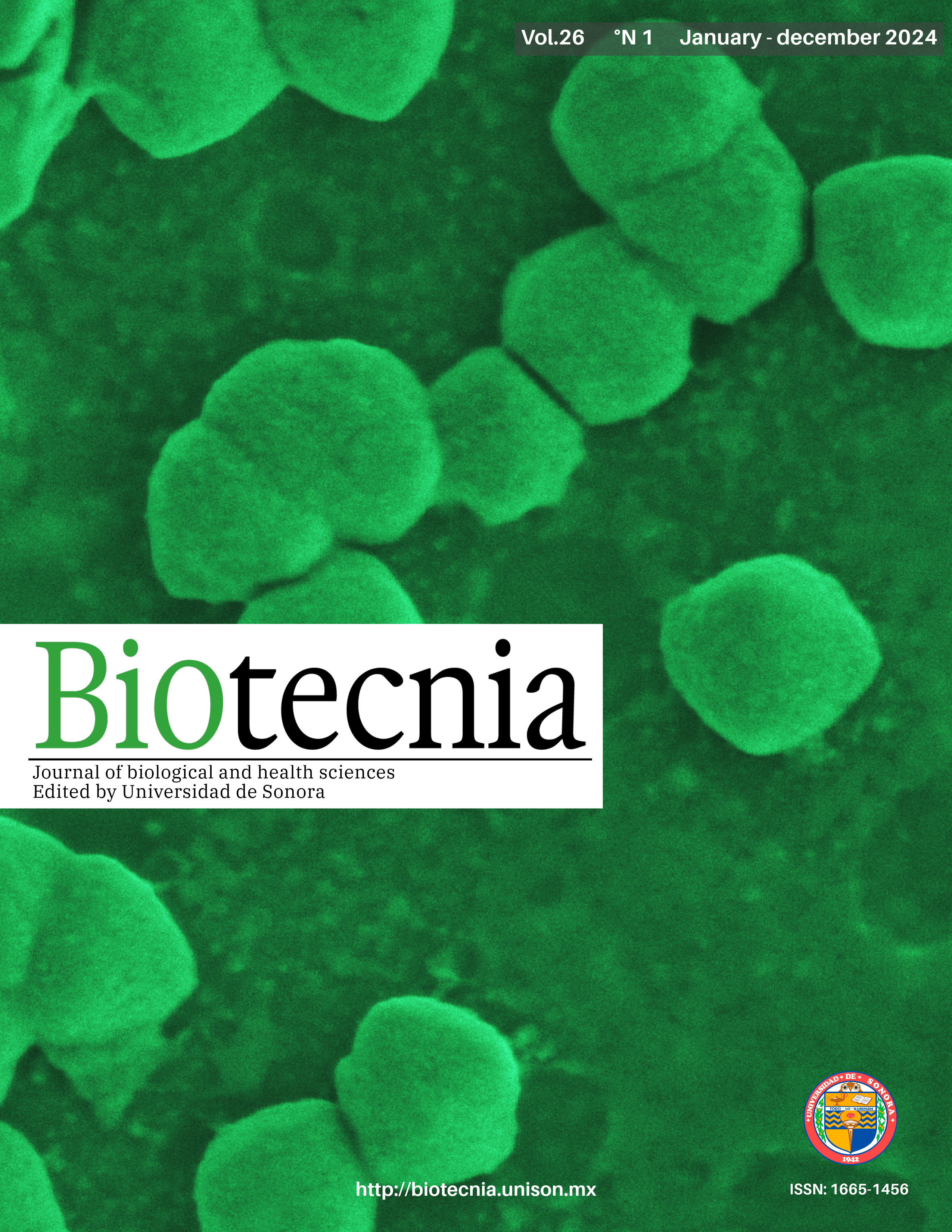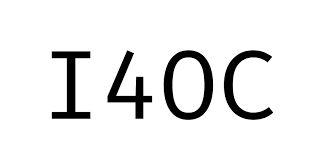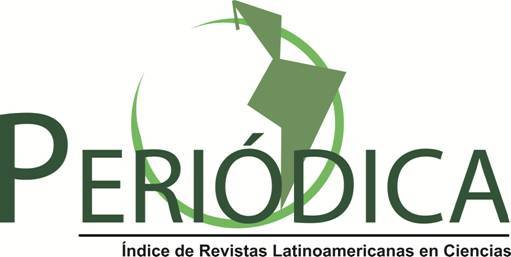Spatial correlation of dengue with socioeconomic status and land temperature in northwest Mexico
Spatial correlation dengue
DOI:
https://doi.org/10.18633/biotecnia.v26.2175Keywords:
Dengue, spatio-temporal analysis, social marginalization, census tract, Mexico.Abstract
Objective. To characterize the geographic distribution of dengue and to evaluate the spatial autocorrelation with social and climatic determinants at the census-tract level in two medium sized cities in northwestern Mexico. Methods. In this work we apply spatial analysis ecological tools, such as the Moran’s Index and the Local Indicator of Spatial Association (LISA) method, to examine global and local spatial correlation between incidence of dengue, and socioeconomic and climatic factors at the census tract-level. For the analysis of the spatial clustering, the Getis-Ord method was used to find statistically significant hot spots in each city. Results. Overall, a global spatial autocorrelation could not be identified, although local clusters of a high dengue incidence, soil surface temperature ≤ 31 °C and high degree of social marginalization coincide. Discussion. We found that at the census-tract level in urban settings, socially disadvantaged populations showed higher clusters of dengue when compared to areas with better socioeconomic conditions. In the two study sites, a similar spatial pattern was observed when considering public health conditions and its aggregation with physical attributes using spatial analysis techniques, supporting the application of this technique for a better understanding about the dengue distribution in urban areas.
Downloads
References
Álvarez G, Lara F, Harlow SD, Denman CA. 2009. Mortalidad infantil y marginación urbana: análisis espacial de su relación en una ciudad de tamaño medio del noroeste mexicano. Rev Panam Salud Pública. 26(1):31-38.
Álvarez-Hernández G, Lara-Valencia F, Reyes-Castro P, Rascón-Pacheco RA. 2010. An analysis of spa-tial and socioeconomic determinants of tuberculosis in Hermosillo, Sonora. 2000-2006. Int J Tub Lung Dis 14 (6): 708-713
Benedum CM, Seidahmed OME, Eltahir EAB, Markuzon N. 2018. Statistical modeling of the effect of rainfall flushing on dengue transmission in Singapore. PLoS Negl Trop Dis 12 (12):e0006935 https://doi.org/10.1371/pntd.0006935
Bhatt S, Gething PW, Brady OJ, Messina JP, Farlow AW, Moyes CL et al. 2013. The global distribution and burden of dengue. Nature 496: 504–7. https://doi.org/10.1038/nature12060
Brady OJ, Gething PW, Bhatt S, Messina JP, Brownstein JS, Hoen AG et al. 2012. Refining the Global spatial limits of dengue virus transmission by evidence-based consensus. PLoS Negl Trop Dis 6, 1–15 https://doi.org/10.1371/journal.pntd.0001760
Celemín JP. 2009. Autocorrelación espacial e indicadores locales de asociación espacial. Importancia, es-tructura y aplicación. Rev Univ Geogr 18: 11–31.
Cortés-Escamilla A, Roche B, Rodríguez-López HM, Lopez-Gatell-Ramírez H, Alpuche-Aranda C. 2022. Spatiotemporal patterns of dengue and zika incidence during the 2015-2018 outbreak of Zika in Mexico. Salud Publica Mex 64: 478-87 https://doi.org/10.21149/13584
do Carmo RF, Silva Jr. JVJ, Pastor AF, Freire-deSouza CD. 2020. Spatiotemporal dynamics, risk areas, and social determinants of dengue in northeastern Brazil, 2014-2017: an ecological study. Infect Dis Poverty 9:153 https://doi.org/10.1186/s40249-020-00772-6
Diez-Roux AV, Aiello A. Multilevel analysis of infectious diseases. 2005. J Infect Dis 191: S25-S33. Doi:10.1086/425288
Dzul-Manzanilla F, Correa-Morales F, Che-Mendoza A, Palacio-Vargas J, Sánchez-Tejeda G, Gonzá-lez-Roldán JF et al. 2021. Identifying urban hotspots of dengue, chikungunya and Zika transmission in Mexico to support risk stratification efforts: a spatial analysis. Lancet Planet Health 5: e277-85
Escobar-Mesa J, Gómez-Dantés H. 2015. Determinantes de la transmisión de dengue en Veracruz: un abordaje ecológico para su control. Salud Publica Mex. 45, 43–53. https://dx.doi.org/10.1590/S0036-36342003000100006
Fan J, Wei W, Bai Z, Fan C, Li S, Liu Q, et al. 2015. A systematic review and meta-analysis of dengue risk with temperature change. Int J Environ Res Public Health 12: 1–15. https://doi.org/10.3390/ijerph120100001
Fuentes-Vallejo M. 2017. Space and space-time distributions of dengue in a hyper-endemic urban space: the case of Girardot, Colombia. BMC Infect Dis 17:512 https://doi.org/10.1186/s12879-017-2610-7
Gobierno de México. 2015. Índice de marginación (carencias poblacionales) por localidad, municipio y entidad. Sonora, 2015. [Internet] México. Consejo Nacional de Población y Vivienda (CONAPO). [Consultado: Octubre 1, 2023] Disponible en:https://datos.gob.mx/busca/dataset/indice-de-marginacion-carencias-poblaciones-por-localidad-municipio-y-entidad
Gobierno de México. 2020. XII Censo Nacional de Población y Vivienda. [Internet] México. Instituto Nacional de Estadística, Geografía e Informática. Sonora. [Consultado: Septiembre 1, 2023] Dispo-nible en: https://www.inegi.org.mx/app/scitel/Default?ev=10
Kikuti M, Cunha GM, Paploski IAD, Kasper AM, Silva MO, Tavares AS, et al. 2015. Spatial distribution of dengue in a Brazilian urban slum setting: role of socioeconomic gradient in disease risk. PLoS Negl Trop Dis 21 (9):e0003937 https://doi.org/10.1371/journal.pntd.0003937
Kolimenakis A, Heinz S, Wilson ML, Winkler V, Yakob L, Michaelikis A et al. 2021. The role of urbani-sation in the spread of Aedes mosquitoes and the diseases they transmit—a systematic review. PLoS Negl Trop Dis 15 (9):e0009631 https://doi.org/10.1371/journal.pntd.0009631
Kourí G. El dengue, un problema creciente de salud en las Américas. 2011. Rev Cuba Salud Publica 37: 616–18. https://doi.org/10.1590/S1020-49892006000300001
Lega J, Brown HE, Barrera R, Editor S, Ritchie S. 2017. Aedes aegypti (Diptera :Culicidae) abundance model improved with relative humidity and precipitation-driven egg hatching. J Med Entomol 54: 1375–84. https://doi.org/10.1093/jme/tjx077
Mena N, Troyo A, Bonilla-Carrión R, Rica C. 2011. Factores asociados con la incidencia de dengue en Costa Rica. Rev Panam Salud Pública 29(4): 234–42.
Montoya RH, Diego J, Zambrano B, Dayan GH, Dick OB. 2012. Review: The history of dengue out-breaks in the Americas. Am J Trop Med Hyg 87: 584–93. https://doi.org/10.4269/ajtmh.2012.11-0770
Navarro-Estupiñán J, Robles-Morúa A, Vivoni ER, Zepeda J, Montoya J, Verduzco VV. 2018. Observed trends and future projections of extreme heat events in Sonora, Mexico. Int J Climatol 38 (14): 5158–81. https://doi.org/10.1002/joc.5719
Navarro-Estupiñan J, Robles-Morua A, Díaz-Caravantes R, Vivoni ER. 2020. Heat risk mapping through spatial analysis of remotely-sensed data and socioeconomic vulnerability in Hermosillo, México. Ur-ban Climate 31, 100576. https://doi.org/10.1016/j.uclim.2019.100576
Ordoñez-Sierra G, Sarmiento-Senior D, Jaramillo-Gomez JF, Giraldo P, Porras-Ramírez A, Olano VA. 2021. Multilevel analysis of social, climatic, and entomological factors that influenced dengue oc-currence in three municipalities in Colombia. One Health 12:100234 https://doi.org/10.1016/j.onehlt.2021.100234
Ogashawara I, Li L, Madriñán MJM. 2019. Spatial‐temporal assessment of environmental factors related to dengue outbreaks in São Paulo, Brazil. Geohealth 3 (8): 202–217. https://doi.org/10.1029/2019GH000186
Peña-García VH, Triana-Chávez O, Mejía-Jaramillo AM, Díaz FJ, Gómez-Palacio A, Arboleda-Sánchez S. 2016. Infection rates by dengue virus in mosquitoes and the influence of temperature may be related to different endemicity patterns in three Colombian cities. Int J Environm Res Public Health 13, 7. https://doi.org/10.3390/ijerph13070734
Peña-García VH, Triana-Chávez O, Arboleda-Sánchez S. 2017. Estimating effects of temperature on dengue transmission in Colombian cities. Ann Glob Health 83 (4): 509–18. https://doi.org/10.1016/j.aogh.2017.10.011
Peeters A, Zude M, Käthner J, Ünlü M, Kanber R, Hetzroni A et al. 2015. Getis–Ord’s hot- and cold-spot statistics as a basis for multivariate spatial clustering of orchard tree data. Comput Electron Agric 111: 140–150. https://doi.org/10.1016/j.compag.2014.12.011
Phanitchat T, Zhao B, Haque U, Pientong C, Ekalaksananan T, Aromseree S, et al. 2019. Spatial and temporal patterns of dengue incidence in northeastern Thailand 2006–2016. BMC Infect Dis 3:1–12. https://doi.org/10.1186/s12879-019-4379-3
Reyes-Castro PA, Harris RB, Brown HE, Christopherson GL, Ernst KC. 2017a. Spatio-temporal and neighborhood characteristics of two dengue outbreaks in two arid cities of Mexico. Acta Trop 167: 174-82. http://dx.doi.org/10.1016/jactatropica.2017.01.001
Reyes-Castro PA, Luque-Castro AL, Díaz-Caravantes R, Walker KR, Hayden MH, Ernst KC. 2017b. Outdoor spatial spraying against dengue: a false sense of security among inhabitants of Hermosillo, Mexico. PLoS Negl Trop Dis 11 (5): e0005611 https://doi.org/10.1371/journal.pntd.0005611
Sorek-Hamer M, Just AC, Kloog I. 2016. Satellite remote sensing in epidemiological studies. Curr Opin Pediatr 28 (2): 228-34 doi:10.1097/MOP.0000000000000326
Teurlai M, Menkes CE, Cavarero V, Degallier N, Descloux E, Grageon JP et al. 2015. Socio-economic and climate factors associated with dengue fever spatial heterogeneity: a worked example in New Caledonia. PLoS Neg Trop Dis 9 (12):e0004211 doi:10.1371/journal.pntd.0004211
Tsou J, Zhuang J, Li Y, Zhang Y. 2017. Urban heat island assessment using the Landsat 8 data: a case study in Shenzhen and Hong Kong. Urban Sci 1 (1): 10. https://doi.org/10.3390/urbansci1010010
Watts MJ, Kotsila P, Mortyn PG, i Monteys VS, Brancati CU. 2020. Influence of socio-economic, demo-graphic and climate factors on the regional distribution of dengue in the United States and Mexico. Int J Health Geograph 19, 44 https://doi.org/10.1186/s12942-020-00241-1
Yang C, He X, Yan F, Yu L, Bu K, Yang J. 2017. Mapping the influence of Land use / Land cover changes on the urban heat island effect — a case study of Changchun, China. Sustainability 9 (2): 312. https://doi.org/10.3390/su9020312
Zellweger RM, Cano J, Mangeas M, Taglioni F, Mercier A, Despinoy M et al. 2017. Socioeconomic and environmental determinants of dengue transmission in an urban setting: an ecological study in Nau-méa, New Caledonia. Plos Negl Trop Dis 11 (4):e0005471 https://doi.org/10.1371/pntd.0005471
Downloads
Published
How to Cite
Issue
Section
License
Copyright (c) 2023

This work is licensed under a Creative Commons Attribution-NonCommercial-ShareAlike 4.0 International License.
The journal Biotecnia is licensed under the Attribution-NonCommercial-ShareAlike 4.0 International (CC BY-NC-SA 4.0) license.

















_(2).jpg)







